Elizabeth Garrett Anderson Hospital
144 Euston Road, NW1 2AP
Medical dates:
Medical character:
Specialist
In 1865 Elizabeth Garrett
(1836-1917) made history by becoming the first woman doctor in the UK,
having fought tirelessly for the right of women to practice medicine,
and despite great opposition from the medical establishment. In
1866, with the backing of her father, a successful businessman, she opened St Mary's Dispensary
at 69 Seymour Place, to provide medical treatment for women as a female
practitioner.
In 1870, at the age of 34, she obtained a medical degree from the University of Paris and became a visiting physician to the East London Hospital for Children. In 1871 she married James Anderson, a successful businessman. In 1872, Lord Shaftesbury opened a 10-bedded ward at the Dispensary, which was renamed the New Hospital for Women. It was staffed entirely by women. In 1873 Dr Garrett became a member of the British Medical Association (BMA), the only women to do so for 19 years because of the BMA's subsequent vote against the admission of any further women.
In 1874 the New Hospital for Women moved to 222-224 Marylebone Road (now the site of the Landmark Hotel).
In 1890 it moved to a new purpose-built building in Euston Road, whose foundation stone had been laid by Alexandra, Princess of Wales, in 1899.
In 1912 Rosa Morison House at 83 Gloucester Road, Barnet, was acquired as a place of recovery for the Hospital's patients.
The New Hospital for Women was renamed Elizabeth Garrett Anderson Hospital in 1918, following the death of its founder.
In the late 1920s additional land adjacent to the Hospital was purchased and the Queen Mary Wing built. The new Wing was officially opened by Queen Mary on 8th May 1929.
In 1937 the Duchess of Kent laid the foundation stone for a new nurses' home. She returned to open the Nurses' House (the word 'House' had been substituted for 'Home') a year later. The building contained sitting rooms, common rooms and 80 bedrooms, as well as accommodation for the Preliminary Training School for nurses. The entrance hall had been designed as a memorial to overseas nurses who had lost their lives during WW1 - 39 members of the Canadian Nursing Service, 24 of the Australian Nursing Service, 15 of the New Zealand Nursing Service, 4 of the South African Nursing Service, 3 of the Colonial Nursing Service and 1 of the Indian Military Nursing Service. A plaque on the wall, bearing the arms of the Dominions, was inscribed:
"This hall and the land on which it stands were given to the Hospital to be a memorial in honour of those overseas nurses who died while serving the Allied Armies, 1914-1918.
For lamentation, memory,
For pity, praise."
In 1946 the Hospital purchased the Hampstead Nursing Home at 40 Belsize Gardens. It became the Garrett Anderson Maternity Home with 27 beds and was opened by Queen Mary in 1948.
In 1948 the Hospital joined the NHS and became a teaching hospital.
It first became threatened with closure following a General Nursing Council decision to stop training nurses there. Without subsidised trainees, financial demands would be increased.
In 1976 the Hospital lifts and fire escapes were declared unsafe. The Secretary of State decided to close the Hospital. The Area Health Authority attempted to transfer the work to the Whittington Hospital, but a major national campaign lobbied to save it, raising £900,000 from the public. After the general election in 1979, the newly elected Prime Minister, Margaret Thatcher, reprieved it and granted £2.4m to convert it into a small gynaecological unit, where women could be treated by women.
The Hospital reopened in 1984 with modern facilities and a new Well Women's Service.
In 1988 Bloomsbury Health Authority decided to close the Hospital for Women in Soho and its services moved to the Elizabeth Garrett Anderson Hospital. This move brought male gynaecologists to the staff of the Hospital, but the principle prevailed that women could choose a female doctor if they preferred. In 1989 it was renamed the rather overlong 'United Elizabeth Garrett Anderson Hospital and Hospital for Women, Soho'.
In yet another NHS reorganisation in 1991, the Hospital came under the management of the Bloomsbury and Islington Health Authority who, in 1992, decided to close its beds and to use it for day surgery only.
In December 2000 the Hospital merged with the Obstetric Hospital at University College Hospital and moved to its premises in Huntley Street. It is now known as the Elizabeth Garrett Anderson and Obstetric Hospital.
The new tower of University College Hospital is named the Elizabeth Garrett Anderson Wing and should be completed this year (2008).
Present status (November 2007)
The building is now derelict and boarded up, but was bought by Unison, the Health Service workers union, in 2006 for their Headquarters at a cost of £18.5m. Parts of the building are Grade I listed.
Update: April 2012
The original Queen Anne style building, built in 1890, was restored with its original boundary wall and railings in 2010. All the other buildings, including the Queen Mary Wing and the Nurses' Home, built in the 1930s, have been demolished. The site now contains a mixed development containing an apartment block and an office tower.
In 1870, at the age of 34, she obtained a medical degree from the University of Paris and became a visiting physician to the East London Hospital for Children. In 1871 she married James Anderson, a successful businessman. In 1872, Lord Shaftesbury opened a 10-bedded ward at the Dispensary, which was renamed the New Hospital for Women. It was staffed entirely by women. In 1873 Dr Garrett became a member of the British Medical Association (BMA), the only women to do so for 19 years because of the BMA's subsequent vote against the admission of any further women.
In 1874 the New Hospital for Women moved to 222-224 Marylebone Road (now the site of the Landmark Hotel).
In 1890 it moved to a new purpose-built building in Euston Road, whose foundation stone had been laid by Alexandra, Princess of Wales, in 1899.
In 1912 Rosa Morison House at 83 Gloucester Road, Barnet, was acquired as a place of recovery for the Hospital's patients.
The New Hospital for Women was renamed Elizabeth Garrett Anderson Hospital in 1918, following the death of its founder.
In the late 1920s additional land adjacent to the Hospital was purchased and the Queen Mary Wing built. The new Wing was officially opened by Queen Mary on 8th May 1929.
In 1937 the Duchess of Kent laid the foundation stone for a new nurses' home. She returned to open the Nurses' House (the word 'House' had been substituted for 'Home') a year later. The building contained sitting rooms, common rooms and 80 bedrooms, as well as accommodation for the Preliminary Training School for nurses. The entrance hall had been designed as a memorial to overseas nurses who had lost their lives during WW1 - 39 members of the Canadian Nursing Service, 24 of the Australian Nursing Service, 15 of the New Zealand Nursing Service, 4 of the South African Nursing Service, 3 of the Colonial Nursing Service and 1 of the Indian Military Nursing Service. A plaque on the wall, bearing the arms of the Dominions, was inscribed:
"This hall and the land on which it stands were given to the Hospital to be a memorial in honour of those overseas nurses who died while serving the Allied Armies, 1914-1918.
For lamentation, memory,
For pity, praise."
In 1946 the Hospital purchased the Hampstead Nursing Home at 40 Belsize Gardens. It became the Garrett Anderson Maternity Home with 27 beds and was opened by Queen Mary in 1948.
In 1948 the Hospital joined the NHS and became a teaching hospital.
It first became threatened with closure following a General Nursing Council decision to stop training nurses there. Without subsidised trainees, financial demands would be increased.
In 1976 the Hospital lifts and fire escapes were declared unsafe. The Secretary of State decided to close the Hospital. The Area Health Authority attempted to transfer the work to the Whittington Hospital, but a major national campaign lobbied to save it, raising £900,000 from the public. After the general election in 1979, the newly elected Prime Minister, Margaret Thatcher, reprieved it and granted £2.4m to convert it into a small gynaecological unit, where women could be treated by women.
The Hospital reopened in 1984 with modern facilities and a new Well Women's Service.
In 1988 Bloomsbury Health Authority decided to close the Hospital for Women in Soho and its services moved to the Elizabeth Garrett Anderson Hospital. This move brought male gynaecologists to the staff of the Hospital, but the principle prevailed that women could choose a female doctor if they preferred. In 1989 it was renamed the rather overlong 'United Elizabeth Garrett Anderson Hospital and Hospital for Women, Soho'.
In yet another NHS reorganisation in 1991, the Hospital came under the management of the Bloomsbury and Islington Health Authority who, in 1992, decided to close its beds and to use it for day surgery only.
In December 2000 the Hospital merged with the Obstetric Hospital at University College Hospital and moved to its premises in Huntley Street. It is now known as the Elizabeth Garrett Anderson and Obstetric Hospital.
The new tower of University College Hospital is named the Elizabeth Garrett Anderson Wing and should be completed this year (2008).
Present status (November 2007)
The building is now derelict and boarded up, but was bought by Unison, the Health Service workers union, in 2006 for their Headquarters at a cost of £18.5m. Parts of the building are Grade I listed.
Update: April 2012
The original Queen Anne style building, built in 1890, was restored with its original boundary wall and railings in 2010. All the other buildings, including the Queen Mary Wing and the Nurses' Home, built in the 1930s, have been demolished. The site now contains a mixed development containing an apartment block and an office tower.
N.B. Photographs obtained in November 2007
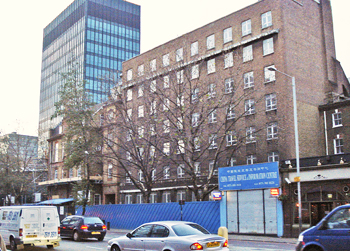

The original hospital building in Euston Road is dwarfed by the later extension.
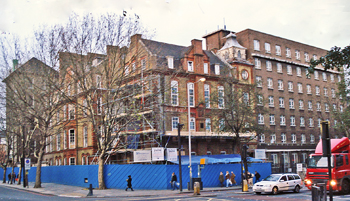
The former Hospital on the corner of Churchway and Euston Road.
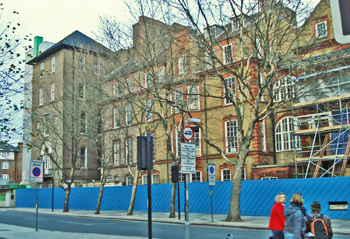
The western elevation in Churchway.

The former main entrance at the end of the building in Churchway.
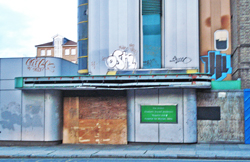
The main doors are boarded up and the walls are covered with graffiti.
Photographs obtained in October 2008
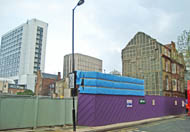

The modern block in Churchway has been demolished and the original Hospital building is being restored.

The Euston Road elevation of the original building (above). The name of the Hospital is barely visible (below).
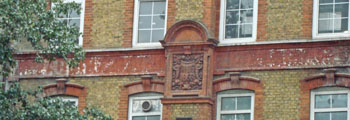

The projected appearance of the new block on Euston Road. The original building on the left is hidden behind trees.
Photographs obtained in May 2011
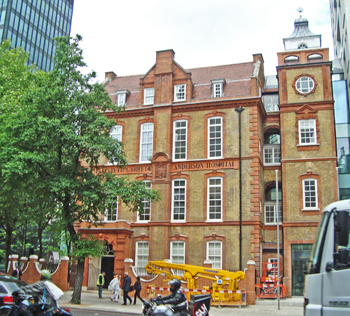
The former Hospital building is almost completely restored.
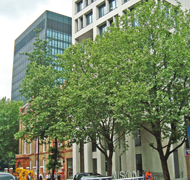
The new office tower has been built beside the Hospital building.
Photographs obtained in October 2011
Photographs obtained in October 2011
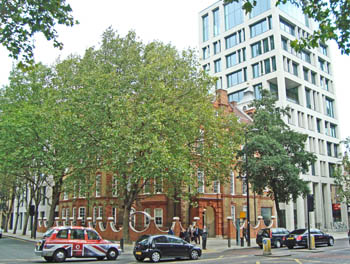
Building works have been completed. The mixed development comprises 47 apartments and the office tower, which contain the headquarters of the Unison trades union.
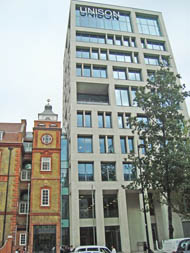
The Unison Centre tower is next to the former Hospital building on Euston Road.
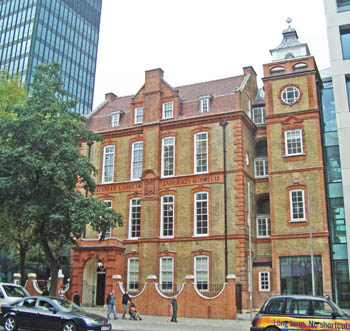
The restored Hospital building contains the Elizabeth Garrett Anderson Gallery, accessible to the public on certain days of the week.

The name of the Hospital along the southern elevation.
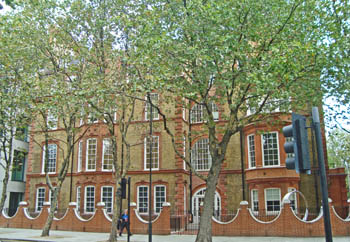
The western elevation of the building in Churchway (above). A smaller tower block has replaced the previous buildings (below) in Churchway.
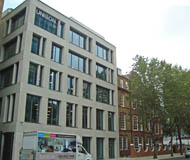
(Author unstated) 1925 Memorial to overseas nurses. Part of the Elizabeth Garrett Anderson Hospital extension. British Journal of Nursing (April), 84.
(Author unstated) 1929 Nursing echoes. British Journal of Nursing (May), 116.
(Author unstated) 1938 The Hospital World. British Journal of Nursing (November), 300.
Aitken J 1966 Elizabeth Garrett Anderson Hospital Centenary. British Medical Journal 2 (5509), 354-355.
http://afroml.blogspot.co.uk
http://discovery.nationalarchives.gov.uk
http://hansard.millbanksystems.com
www.derelictlondon.com
www.donaldinsallassociates.co.uk
www.falconstructural.co.uk
www.flickr.com
www.pastscape.org.uk
www.ucl.ac.uk
www.victorianweb.org
Return to home page